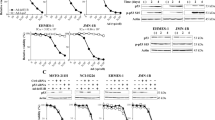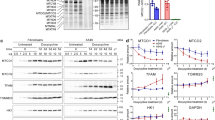Abstract
Adenoviral delivery of the p53 gene is a potential therapeutic approach for the treatment of lung cancer. Furthermore, amifostine is a cytoprotective agent and recent reports have described its potentiation of chemotherapy's antitumor activity in lung cancer. Therefore, we wished to investigate the ability of amifostine both alone and in combination with p53-based therapy to induce apoptosis, and to understand the mechanisms by which this apoptosis occurs. Using p53 null and wild-type p53 human lung cancer cells and normal human bronchial epithelial cells, we evaluated the effects of amifostine on proliferation and apoptosis. We then analyzed Adp53 in combination with amifostine and performed isobologram analysis. Expression of p53, p21WAF1, Bax, Bak, bcl-2, as well as total and phosphorylated Cdc2 in the absence and presence of olomoucine, a phosphorylated Cdc2 kinase inhibitor, was then determined. Amifostine-induced apoptosis in human lung cancer cells in a dose-dependent fashion. The combination of amifostine and Adp53 significantly enhanced, with a supra-additive effect, the inhibition of proliferation of lung cancer cells. This enhancement of apoptosis by amifostine was associated with activation of p53 and dephosphorylation of Cdc2 proteins. Notably, olomoucine effectively prevented amifostine and/or Adp53-induced Cdc2 kinase activation and subsequent apoptosis. Our data shows that amifostine alone can induce apoptosis of human lung cancer cells, and that the combination of Adp53 with amifostine resulted in significantly higher levels of apoptosis. In addition, it appears that Cdc2 kinase plays an important role in the induction of apoptosis by amifostine and Adp53.
This is a preview of subscription content, access via your institution
Access options
Subscribe to this journal
Receive 12 print issues and online access
$259.00 per year
only $21.58 per issue
Buy this article
- Purchase on Springer Link
- Instant access to full article PDF
Prices may be subject to local taxes which are calculated during checkout







Similar content being viewed by others
References
Thompson CB . Apoptosis in the pathogenesis, treatment of disease. Science 1995; 267: 1456–1462.
Prives C, Hall PA . The p53 pathway. J Pathol 1999; 187: 112–126.
Akgul C, Moulding DA, Edwards SW . Alternative splicing of Bcl-2-related genes: functional consequences, potential therapeutic applications. Cell Mol Life Sci 2004; 61: 2189–2199.
Cartron PF, Juin P, Oliver L, Meflah K, Vallette FM . Impact of proapoptotic proteins Bax and Bak in tumor progression and response to treatment. Expert Rev Anticancer Ther 2003; 3: 563–570.
Sharpless NE, DePinho RA . p53: good cop/bad cop. Cell 2002; 110: 9–12.
Levine AJ . p53, the cellular gatekeeper for growth and division. Cell 1997; 88: 323–331.
Swisher SG, Roth JA, Nemunaitis A, Lawrence DD, Kemp BL, Carrasco CH et al. Adenovirus-mediated p53 gene transfer in advanced non-small-cell lung cancer. J Natl Cancer Inst 1999; 91: 763–771.
Ndoye A, Merlin JL, Leroux A, Dolivet G, Erbacher P, Behr JP et al. Enhanced gene transfer and cell death following p53 gene transfer using photochemical internalisation of glucosylated PEI-DNA complexes. J Gene Med 2004; 6: 884–894.
Wolf JK, Bodurka DC, Gano JB, Deavers M, Ramondetta L, Ramirez PT et al. A phase I study of Adp53 (INGN 201; ADVEXIN) for patients with platinum- and paclitaxel-resistant epithelial ovarian cancer. Gynecol Oncol 2004; 94: 442–448.
Haupt S, Haupt Y . Improving cancer therapy through p53 management. Cell Cycle 2004; 3: 912–916.
Neyns B, Noppen M . Intratumoral gene therapy for non-small cell lung cancer: current status and future directions. Monaldi Arch Chest Dis 2003; 59: 287–295.
Schiller JH, Storer B, Berlin J, Wittenkeller J, Larson M, Pharo L et al. Amifostine, cisplatin, and vinblastine in metastatic non-small-cell lung cancer: a report of high response rates and prolonged survival. J Clin Oncol 1996; 14: 1913–1921.
Glover D, Glick JH, Weiler C, Fox K, Guerry D . WR-2721 and high-dose cisplatin: an active combination in the treatment of metastatic melanoma. J Clin Oncol 1987; 5: 574–578.
Roth JA, Nguyen D, Lawrence DD, Kemp BL, Carrasco CH, Ferson DZ et al. Retrovirus-mediated wild-type p53 gene transfer to tumors of patients with lung cancer. Nat Med 1996; 2: 985–991.
Pataer A, Vorburger SA, Barber GN, Chada S, Mhashilkar AM, Zou-Yang H et al. Adenoviral transfer of the melanoma differentiation-associated gene 7 (mda7) induces apoptosis of lung cancer cells via up-regulation of the double-stranded RNA-dependent protein kinase (PKR). Cancer Res 2002; 62: 2239–2243.
Steel GG, Peckham MJ . Exploitable mechanisms in combined radiotherapy-chemotherapy: the concept of additivity. Int J Radiat Oncol Biol Phys 1979; 5: 85–91.
Pines J . Cell cycle and checkpoint on the nuclear frontier. Nature 1999; 397: 104–105.
Ribizzi I, Darnowski JW, Goulette FA, Sertoli MR, Calabresi P . Amifostine cytotoxicity and induction of apoptosis in a human myelodysplastic cell line. Leuk Res 2000; 24: 519–525.
Giannopoulou E, Katsoris P, Kardamakis D, Papadimitriou E . Amifostine inhibits angiogenesis in vivo. J Pharmacol Exp Ther 2003; 304: 729–737.
Grdina DJ, Kataoka Y, Murley JS, Hunter N, Weichselbaum RR, Milas L . Inhibition of spontaneous metastases formation by amifostine. Int J Cancer 2002; 97: 135–141.
North S, El-Ghissassi F, Pluquet O, Verhaegh G, Hainaut P . The cytoprotective aminothiol WR1065 activates p21waf-1 and down regulates cell cycle progression through a p53-dependent pathway. Oncogene 2000; 19: 1206–1214.
Lee EJ, Gerhold M, Palmer MW, Christen RD . p53 protein regulates the effects of amifostine on apoptosis, cell cycle progression, and cytoprotection. Br J Cancer 2003; 88: 754–759.
Kataoka Y, Murley JS, Patel R, Grdina DJ . Cytoprotection by WR-1065, the active form of amifostine, is independent of p53 status in human malignant glioma cell lines. Int J Radiat Biol 2000; 76: 633–639.
Huang TS, Shu CH, Yang WK, Whang-Peng J . Activation of CDC 25 phosphatase and CDC 2 kinase involved in GL331-induced apoptosis. Cancer Res 1997; 57: 2974–2978.
Shen SC, Huang TS, Jee SH, Luo ML . Taxol-induced p34cdc2 kinase activation and apoptosis inhibited by 12-O-tetradecanoylphorbol-13-acetate in human breast MCF-7 carcinoma cells. Cell Growth Differ 1998; 9: 23–29.
Martin SJ, McGahon AJ, Nisioka WK, LaFace D, Guo X, Th'ng J et al. p34cdc2 and apoptosis. Science 1995; 269: 106–107.
Hsu SL, Chen MC, Chou YH, Hwang GY, Yin SC . Induction of p21(CIP1/Waf1) and activation of p34(cdc2) involved in retinoic acid-induced apoptosis in human hepatoma Hep3B cells. Exp Cell Res 1999; 248: 87–96.
Liu HS, Chen CY, Lee CH, Chou YI . Selective activation of oncogenic Ha-ras-induced apoptosis in NIH/3T3 cells. Br J Cancer 1998; 77: 1777–1786.
Zaffaroni N, Silvestrini R, Orlandi L, Bearzatto A, Gornati D, Villa R . Induction of apoptosis by taxol and cisplatin and effect on cell cycle-related proteins in cisplatin-sensitive and -resistant human ovarian cells. Br J Cancer 1998; 77: 1378–1385.
Kyprianou N, Bains A, Rhee JG . Transient tyrosine phosphorylation of p34cdc2 is an early event in radiation-induced apoptosis of prostate cancer cells. Prostate 1997; 32: 266–271.
Yao SL, Akhtar AJ, McKenna KA, Bedi GC, Sidransky D, Mabry M et al. Selective radiosensitization of p53-deficient cells by caffeine-mediated activation of p34cdc2 kinase. Nat Med 1996; 2: 1140–1143.
Cohen-Jonathan E, Toulas C, Monteil S, Couderc B, Maret A, Bard JJ et al. Radioresistance induced by the high molecular forms of the basic fibroblast growth factor is associated with an increased G2 delay and a hyperphosphorylation of p34CDC2 in HeLa cells. Cancer Res 1997; 57: 1364–1370.
Shi L, Nishioka WK, Th'ng J, Bradbury EM, Litchfield DW, Greenberg AH . Premature p34cdc2 activation required for apoptosis. Science 1994; 263: 1143–1145.
Furukawa Y, Iwase S, Terui Y, Kikuchi J, Sakai T, Nakamura M et al. Transcriptional activation of the cdc2 gene is associated with Fas-induced apoptosis of human hematopoietic cells. J Biol Chem 1996; 271: 28469–28477.
Yao SL, McKenna KA, Sharkis SJ, Bedi A . Requirement of p34cdc2 kinase for apoptosis mediated by the Fas/APO-1 receptor and interleukin 1beta-converting enzyme-related proteases. Cancer Res 1996; 56: 4551–4555.
Shimizu T, O'Connor PM, Kohn KW, Pommier Y . Unscheduled activation of cyclin B1/Cdc2 kinase in human promyelocytic leukemia cell line HL60 cells undergoing apoptosis induced by DNA damage. Cancer Res 1995; 55: 228–231.
Fotedar R, Flatt J, Gupta S, Margolis RL, Fitzgerald P, Messier H et al. Activation-induced T-cell death is cell cycle dependent and regulated by cyclin B. Mol Cell Biol 1995; 15: 932–942.
Ongkeko W, Ferguson DJ, Harris AL, Norbury C . Inactivation of Cdc2 increases the level of apoptosis induced by DNA damage. J Cell Sci 1995; 108: 2897–2904.
Bedi A, Barber JP, Bedi GC, el-Deiry WS, Sidransky D, Vala MS et al. BCR-ABL-mediated inhibition of apoptosis with delay of G2/M transition after DNA damage: a mechanism of resistance to multiple anticancer agents. Blood 1995; 86: 1148–1158.
Acknowledgements
This work was supported by grants from the National Cancer Institute and the National Institutes of Health (P01 CA78778-01A1) (JAR, SGS); (SBIR S/C 1R43 CA86587-1) (SGS, SC); SPORE 2P50-CA70970-04); CA97598 and CA89778 (SC); by gifts to the Division of Surgery, from Tenneco and Exxon for the Core Laboratory Facility; by the UTMD Anderson Cancer Center Support Core Grant (CA 16672); by donations from the Charles Rogers Memorial and support from the Homer Flower Research Fund; by a grant from the Tobacco Settlement Funds as appropriated by the Texas State Legislature (Project 8), the WM Keck Foundation.
Author information
Authors and Affiliations
Corresponding author
Rights and permissions
About this article
Cite this article
Pataer, A., Fanale, M., Roth, J. et al. Induction of apoptosis in human lung cancer cells following treatment with amifostine and an adenoviral vector containing wild-type p53. Cancer Gene Ther 13, 806–814 (2006). https://doi.org/10.1038/sj.cgt.7700960
Received:
Revised:
Accepted:
Published:
Issue Date:
DOI: https://doi.org/10.1038/sj.cgt.7700960
Keywords
This article is cited by
-
Inactivated Sendai virus strain Tianjin, a novel genotype of Sendai virus, inhibits growth of murine colon carcinoma through inducing immune responses and apoptosis
Journal of Translational Medicine (2013)
-
Overexpression of SUMO-1 in hepatocellular carcinoma: a latent target for diagnosis and therapy of hepatoma
Journal of Cancer Research and Clinical Oncology (2011)
-
Analysis of transactivation capability and conformation of p53 temperature-dependent mutants and their reactivation by amifostine in yeast
Oncogene (2008)



